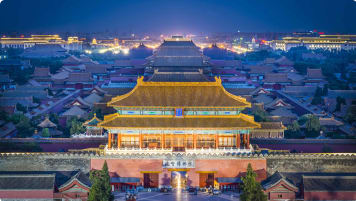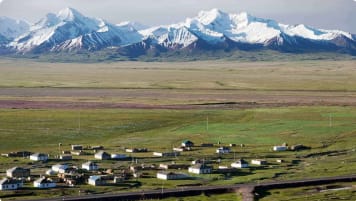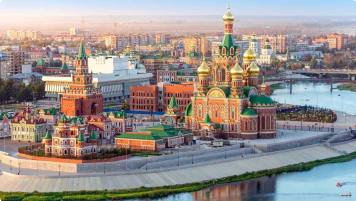Trans-Siberian Railway: Travel advice
The Trans Siberian rail journey, often a must do for many travellers. Join a small group package tour travelling on the Trans Siberian for mature and senior travellers, couples and solo travellers. Vladivostok, Krasnoyarsk, St Petersburg, Irkutsk all feature on this unique rail journey.
4 Jul 20 · 9 mins read

Trans Siberian Railway: Travel advice.
What is it?
The trans-Siberian railway was once hailed ‘the fairest jewel in the land of the Tsars’. Crossing Russia, Mongolia and China, this web of tracks provides unrivalled views of a changing landscape and a journey through cultures from European Russia to the Pacific edge. From life aboard the train — sleeping in its carriages on overnights between far-flung cities and picnicking with the locals — to the exploratory stopovers you will take along the way, the trans-Siberian train is a truly unique experience. Life is a little different on the railway.
In this article:
- we share what you can expect from a trip aboard the trans-Siberian railway.
- we detail the process of booking a ticket
- detail organising a visa
- and share tips for how best to prepare for this journey.
Odyssey has published an article on the history of the Trans Siberia railway.
Read about the landscape and wildlife in this part of Siberia

FAQs about the Trans Siberian Railway
What will I see on the Trans Siberian train journey?
The trans Siberian region can be explored by different routes, each taking different lengths of time. Major stops call for several days each, in order to be fully appreciated. There are options to diverge from the usual track, and such detours reward curious travellers. But no matter how you choose to experience the trans Siberian express, the memories will stay with you, train travel through real Russia.
A journey from Ulaan baatar (Ulan bator) to Moscow will allow the desert, taiga and Mongolian steppe to unfold before your eyes. Be sure to allow several days in Moscow in order to enoy a city tour and visit the Kremlin and Red Square. Its walls house a treasure trove of art, and the domes of nearby St Basil’s cathedral complete a postcard-perfect picture of Russian history. Ulaan baatar (Ulan bator) is vastly different, but equally impressive. Mongolia‘s capital was once a nomadic Buddhist centre, becoming permanent in the 18th century. It is vibrant, industrialised and boasts a bohemian subculture, but the country’s traditions are still palpable here.
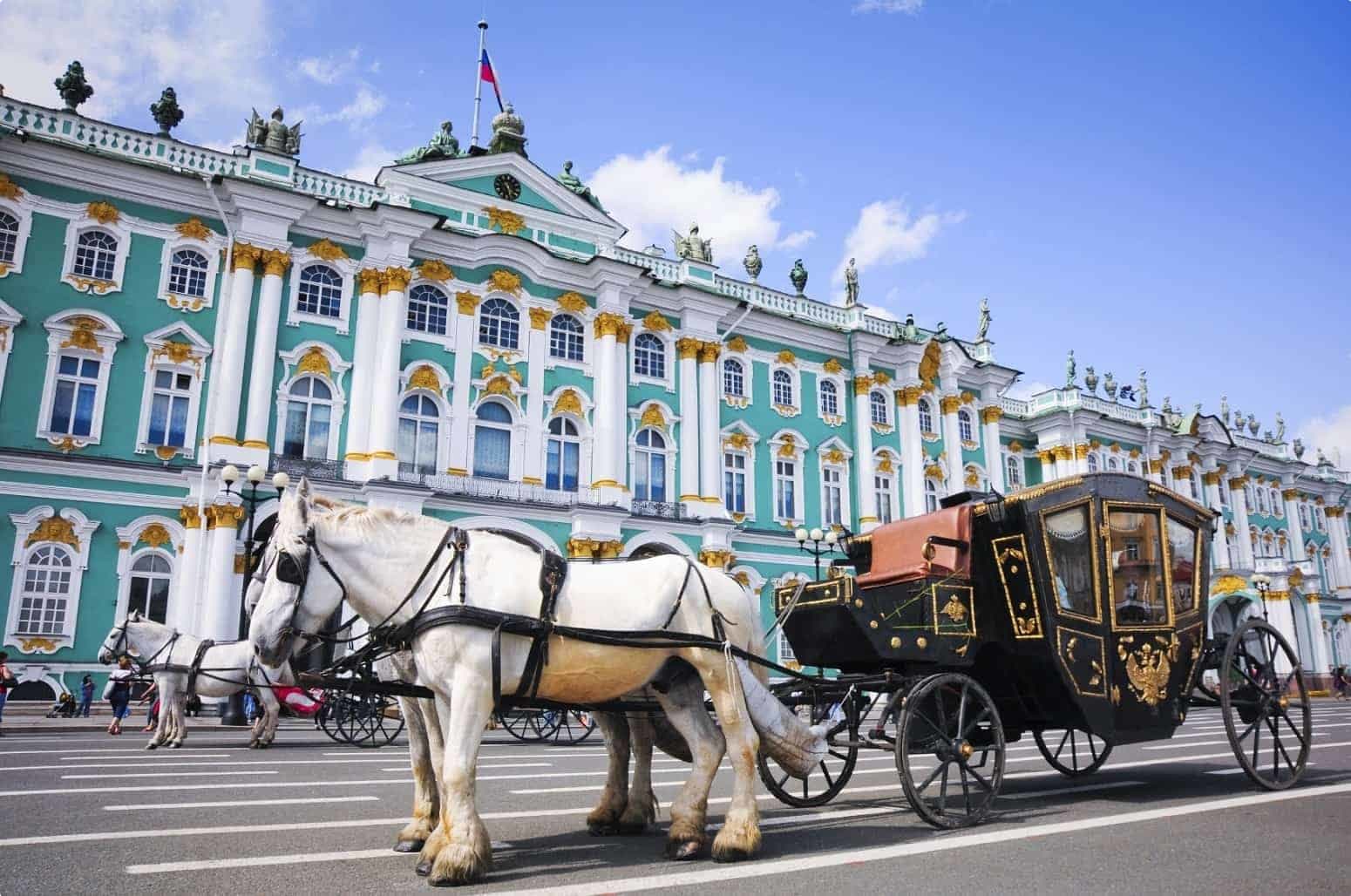
Carriage near the Hermitage in St. Petersburg
Or, you might choose to travel St Petersburg to Irkutsk through the Siberian landscape. Highlights of this route include Novosibirsk, Siberia‘s unofficial capital and home to a lively arts scene. Here and elsewhere, you will find Siberia‘s traditional wooden architecture (izby). The city of Suzdal, to the west, is filled with impressive religious architecture, while Olkhon Island has a different spiritual story, sacred to shamanic western Buryats. It sits on Lake Baikal‘s western shore.
It is possible to loop from Beijing to Harbin, Chita, Slyudyanka, Ulaanbaatar and back again. It takes in the changing landscapes and cultures of all three countries. Harbin is reached overnight, and its architecture tells of the arrival of the Russians at the end of the 19th century, when they commenced the epic railway. Another overnight ride will bring you to the Chinese-Russian border, where you can either continue aboard for Moscow, or transfer by bus to a different trainbound for Chita, west of beautiful Lake Baikal. Irkutsk is the most popular city from which to appreciate the world’s largest freshwater lake. Cross the Gobi Desert on the way back to Beijing.
Another train journey is the Baikal-Amur Mailine, or BAM, which leads you through some of Siberia‘s most rugged country. The BAM takes in the less-visited northern tip of Baikal lake, and Bratsk – home to an open-air ethnographic museum that highlights Siberian traditions. The train climbs and tunnels through mountains en route to Tynda, and Komsomolsk-on-Amure, an attractive city in Russia‘s far-east, eastern Siberia.
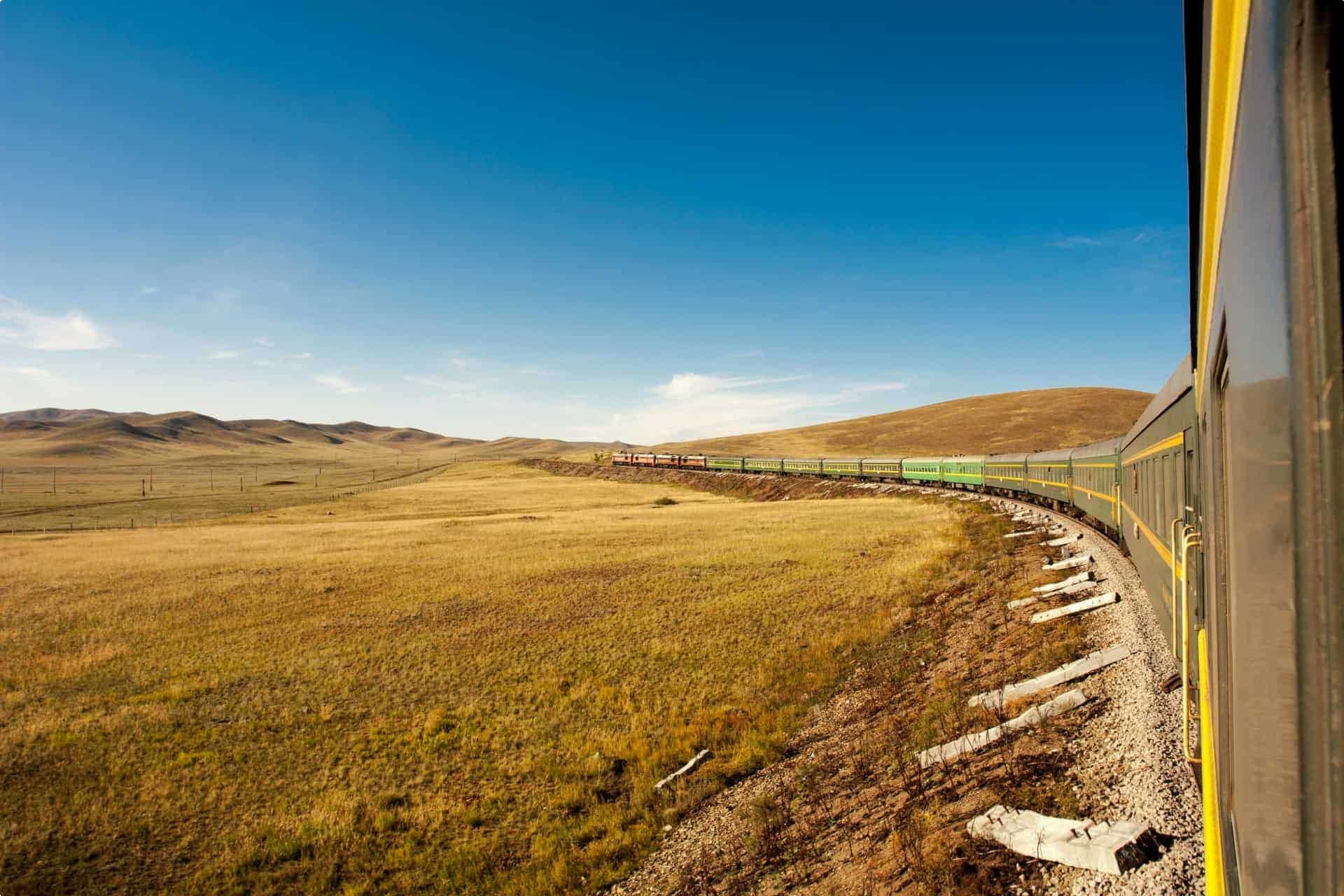
What will I experience on the Trans Siberian rail journey?
Trains along the trans Siberian railway typically move at around 60km/hour. It is hardly a speed train, and this is reflected by the relaxed pace of the passengers within. Some affectionately call it “beyond the realm of time”. There are several options for travel here. The Golden Eagle is a luxury private train generally considered the top of the line, or “deluxe first class” as it is often classified. The Russian trains are the more common, and authentic option. They are divided into three classes, and serviced by the provodnitsa, a (usually) female attendant who cuts an intimidating figure in her military-style uniform but keeps things running smoothly. Treat her with respect and friendliness and chances are, she’ll do the same.
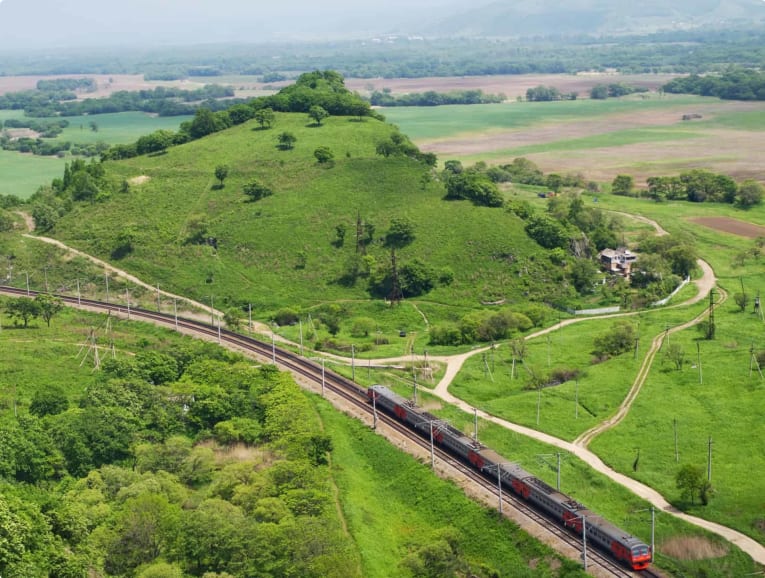
The train moving thorough Russia‘s Primorsky region
3rd class or platskart
This is an open-plan and mixed-gender car without privacy, but with a great sense of community and camaraderie, perhaps this is “real Russia“. Travellers in third class share food and talk openly with their fellow passengers. Despite the lack of security (there are no lockable compartments here), many describe it as feeling safe because people look out for one another. Some women travelling alone prefer this class to second, where the confines of a compartment shared with strangers may in fact be less appealing.
Platskart is a remarkable experience, but if possible, is best avoided for long journeys. After three days, even the friendliest of atmospheres wears thin, and though all trains are technically air-conditioned, they are known to break down. Such an incident is very unpleasant while riding in platskart . If you would like to try it, consider taking third class for a shorter trip.
A section of the Circum-Baikal railway during winter
2nd class or kupe
Third class offers nine ‘virtual’ compartments; second class provides nine real ones. They feature four bunks, a fold-down table and a lockable door. Second class provides greater comfort and breathing space, but can be a bit of a lottery depending on who you share your compartment with. A group of vodka-drunk men tends to be the worst case, but you are more likely to meet people who will soon become friends.
1st class or SV (short for spalny vagon or sleeping car)
First class is more roomy and comfortable again, offering lockable compartments of two berths. They often have televisions with DVD players, and the provodnitsa can lend you a DVD for a small fee. But then, why would you, when you also have a window onto the Gobi Desert or the Vologda River? A ticket on first class will help you to unwind and settle into the pace of the train journey here. It is a popular choice for international travellers, because it combines comfort with the opportunity to still meet local people on board. You will likely find that Russians are friendly and generous with their time, and Chinese passengers curious and happy to chat.

The trans-Siberian railways between Beijing, China and Ulaanbaatar, Mongolia
Facilities
Fresh bed linen and a hand towel are provided. Some first class compartments may have an en suite , but usually, the toilets are found at either end of the carriage. The all important samovar is where you will find hot water for beverages. It is serviced by the provodnitsa and kept very well. Do not drink the water in the bathrooms; rather, the samovar is your safest option. It is a good idea to bring a small kit of basic eating utensils, like a camping mug for cups of tea. Some tickets include small snacks which will be distributed by the provodnitsa, and there are usually restaurant cars attached. The cars are changed at each country border, meaning a new menu will become available. Food typically isn’t the highlight of the trans Siberian railway – though it’s said the Chinese menu is usually the best. But platforms are frequently abuzz with supplies – from bread and dairy, to home cooked dumplings and pies, and in Siberia, ubiquitous pine and cedar nuts. Keep small change on hand for this. Do as the locals do and stock up on goods for a picnic on board. Share this will your fellow travellers and these picnics will soon become the highlight of your trip.
How can I prepare for my Trans Siberian rail journey?
Preparation for the trans Siberian railway is a meticulous affair. Tickets cannot be purchased until 90 days before departure, some visas, like a Russian visa, require a formal invitation, and trains do not wait for you if you’re running late. But with some forward planning, it can all come together and your journey through Russia, Mongolia and China will be as smooth as can be hoped.

Booking your train ticket
Once you have determined that you would like to experience the trans Siberian railway, several more decisions must be made. You will need to select your desired route, the level of comfort you are seeking, and the time you wish to travel. All of these factors will be reflected in the cost of your ticket. Given the popularity of this international route, advanced booking is advised, especially in busy summer months.
Advance booking options
Russia‘s trains are a good option. They are reliable and offer a variety of classes. Tickets aboard Russian trains can be booked 45 days prior to your departure. In Mongolia, on the other hand, tickets from Ulaanbaatar to Moscow and Beijing are booked closer to travel time – in some instances just a day in advance, but usually up to 10. In China, advance booking options depend on the service, ranging from 5 to 20 days before travel. In all cases, a booking agency can facilitate earlier reservations. It is more expensive to book a ticket through an agency, but may be worthwhile for convenience. Many local agents can also take bookings from abroad.
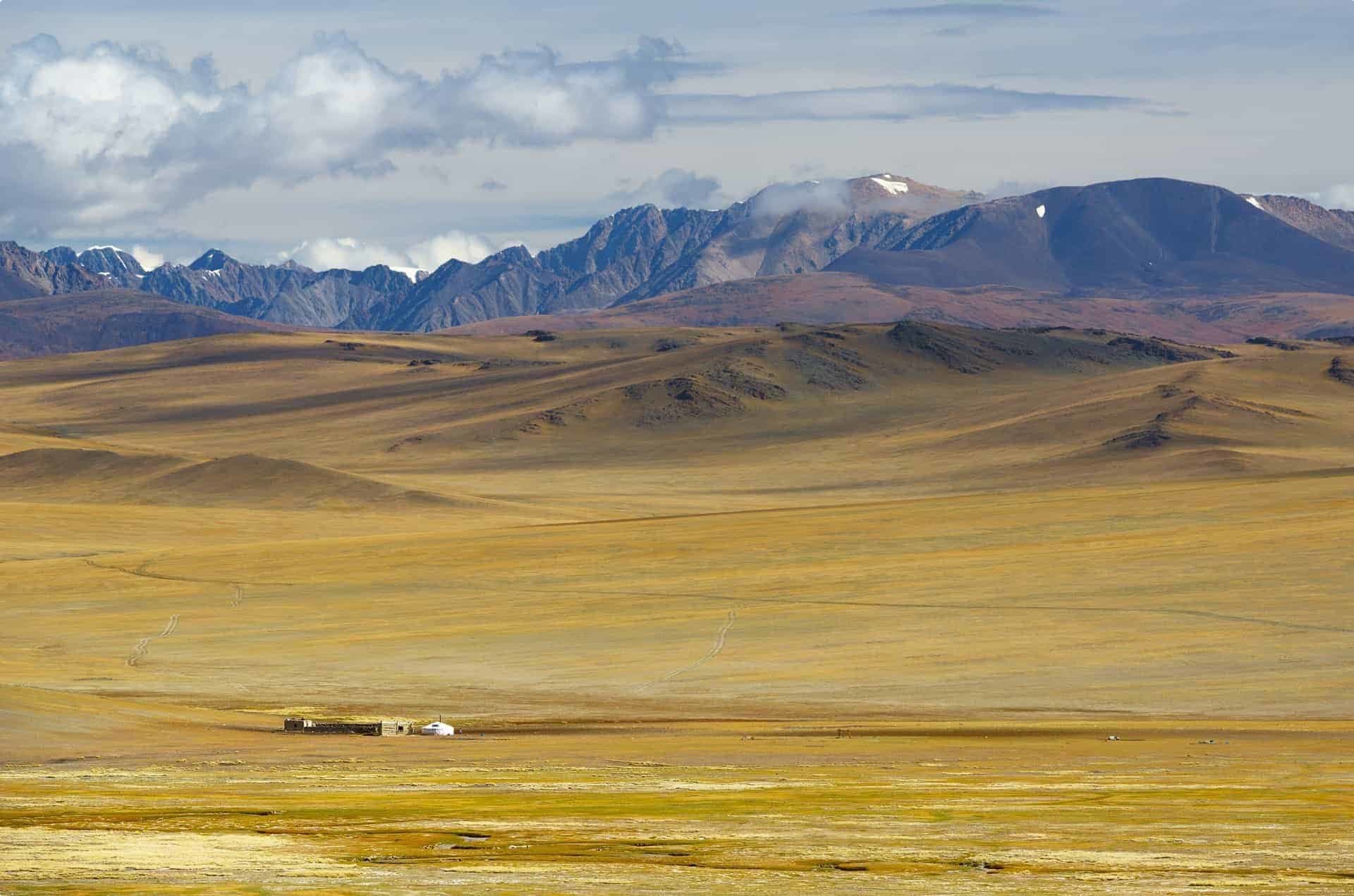
Mongolia‘s sun-kissed steppe landscape
Purchasing your tickets: Russia
If you are purchasing your ticket once you have arrived, this process differs according to your country of residence. In any case, make sure you bring your passport with you to book. In Russia, tickets can be bought online, at Russian railway booking offices or private rail booking offices. Major stations have ticket machines where you can use your card to buy on the spot, or to pick up pre-booked tickets. But if these are not available, you will have to use the staffed ticket windows. These tend to have slow-moving queues, and non-English speaking attendants. Allow plenty of time if you are taking this option, and consider paying a small fee for a booking office if one is nearby. Local travel agents can also help.
Purchasing your tickets: Mongolia and China
In Mongolia, the trans Siberian railway is not available for domestic travel. Tickets are for international destinations only. Try to book your seat as far in advance as you can – something that you will likely need to do at the station, or through websites or local booking companies. Reception staff at your hotel will be a great resource for this.
Finally, in China, purchasing tickets at the train station is generally the cheapest option. Staff may not speak English, but Chinese rail expert Duncan Peattie has created a booking form which you might like to print, complete, and present at the desk. Mark Smith has produced a detailed account of the tickets for the Chinese rail and his website, “The Man in Seat 61” , is an excellent resource for anyone interested in rail travel.
If possible, it helps to have someone write the following information in the local language for you to present to the ticket attendant, as minimum:
- Number of tickets required
- Destination
- Class of ticket
- Preferred date and time of departure
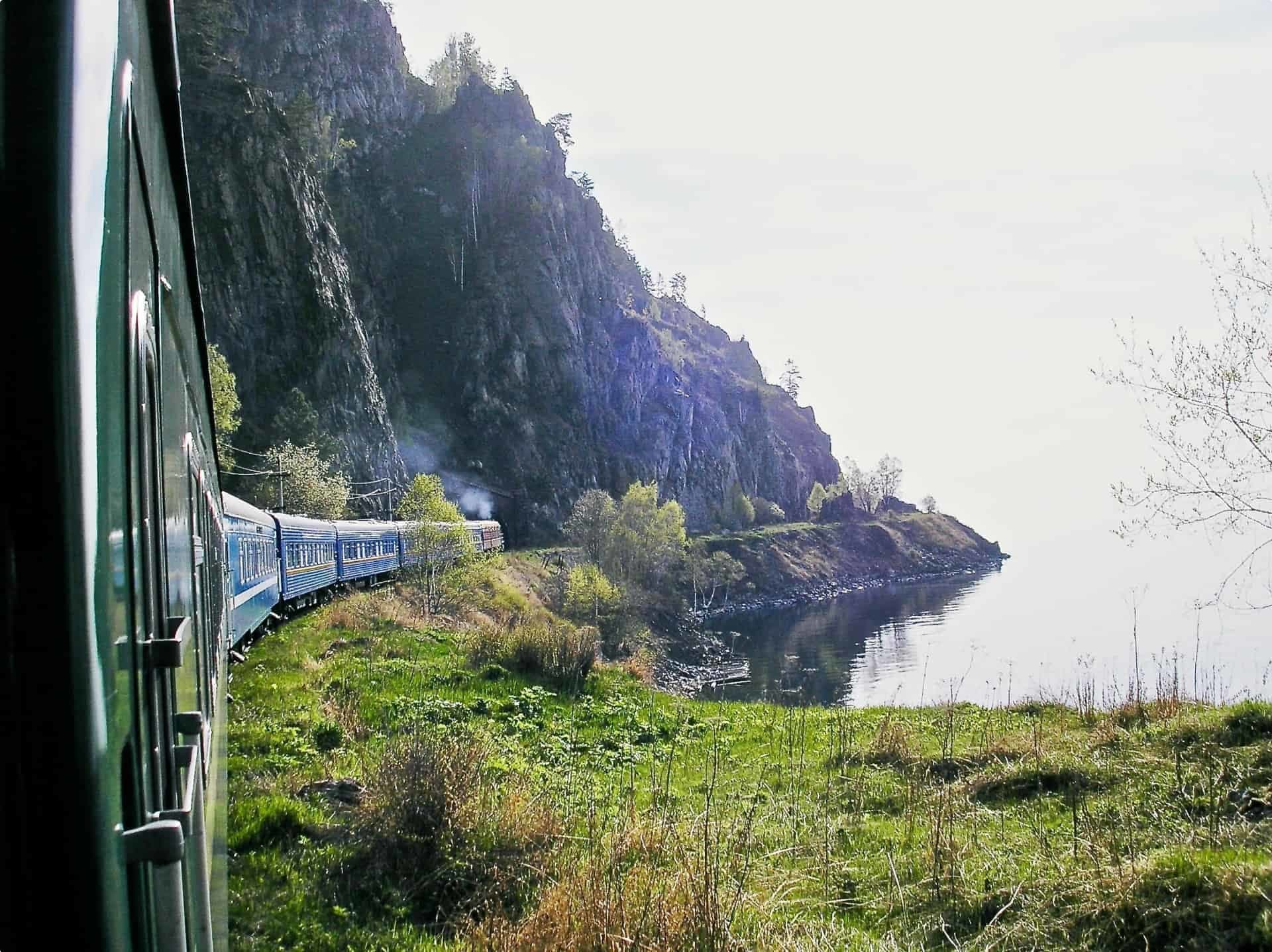
A trans-Siberian train skirting Lake Baikal
Reading a Russian train ticket
Again, do bring your passport when booking because the number and your name will be printed on the ticket. The provodnitsa will check your passport as you board the train, ensuring that the details match up. For this reason, it is important that the seller has the correct information. A Russian train ticket is an intimidating document with many components! It specifies the train number, which indicates the standard and price of your ticket. The lower the number, the better (anything beneath 100 is good). If this number is odd, the train heads toward Moscow; even numbers travel east away from the capital.
Your bed number will be printed on this ticket, but if it is left blank, will be allocated by the provodnitsa on boarding. Your passport number is prefixed by numbers indicating the passport type. The cost of your ticket and service charges will be printed, along with departure date, time, carriage number and ticket class. The number of people travelling on this ticket, as well as their type (adult, child, student) is included. Arrival date and time are listed.
Tickets are computer printed with a duplicate copy. Sometime the provodnitsa will collect both, returning one on your arrival; other times she will leave you with a copy that has been slightly ripped to indicate its use. Carry this with you as it will be handy for hopping on and off trains at stops. It provides evidence of how long you have been in a particular location, which you may need if stopped by police.
Organising your visa for travel
It is important to prepare in advance for travel on the trans Siberian railway because visas are not issued at land borders, and each country requires a different application process. In general, visas are valid for entry within three months of issue, so they must not be arranged too far in advance. The easiest option is to organise your visa from your country of residence. Read on for more detail on each of the three countries but please note that this is general advice only and should not be relied upon for your specific travel needs.
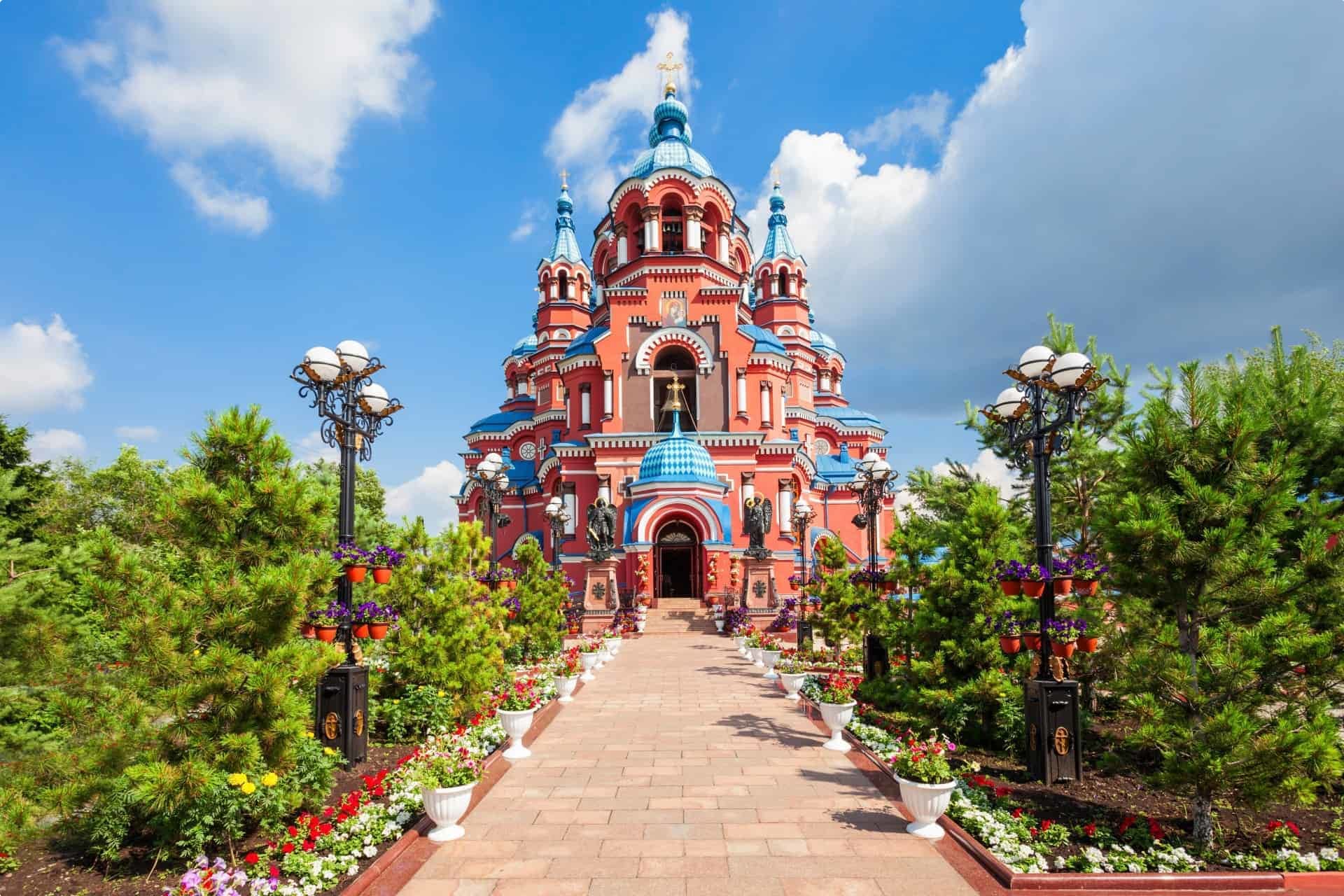
Iconic Kazan Cathedral in Irkutsk, Russia
Visas for Mongolia
Citizens from some countries, including the USA, can stay for up to 90 days without a visa. If they exceed 30 days, they need to register but otherwise, nothing needs to be done. From others, like Canada and Japan, a stay of up to 30 days is permissible without a visa; for Hong Kong residents up to 14 days. Australian visitors need to obtain a visa. All visitors who stay beyond 30 days must register at the Office of Immigration, Naturalisation and Foreign Citizens for a fee. Visas can be extended before they expire, but this attracts further fees. Fines are issued for failure to extend in time.
A single-entry transit visa can be arranged; these are valid for up to 72 hours from issue – enough time for you to transfer between trains at Ulaanbaatar if you are continuing on to China or Russia. A train or plane ticket and a visa for the next country must be presented in order to obtain a single entry visa. Further information on Mongolian visas can be found here .
Visas for China
Visas are required for visits to China. There are some exceptions, including visa-free visits to Hong Kong and Macau, and 72-hour transit stays for travellers from certain nations, and to stay in certain cities. Additionally, residents from some countries are permitted to stay visa-free for less than 15 days, while further restrictions are placed on regions like Tibet.
Standard, 30 days visas can be issued within 4-5 working days. In many countries, the service has shifted from the embassy to a compulsory Chinese Visa Application Centre , which charges an additional fee. A standard visa is activated on the day you arrive in China and must be used within three months of issue. Allow for up to three weeks to have your visa mailed to you.
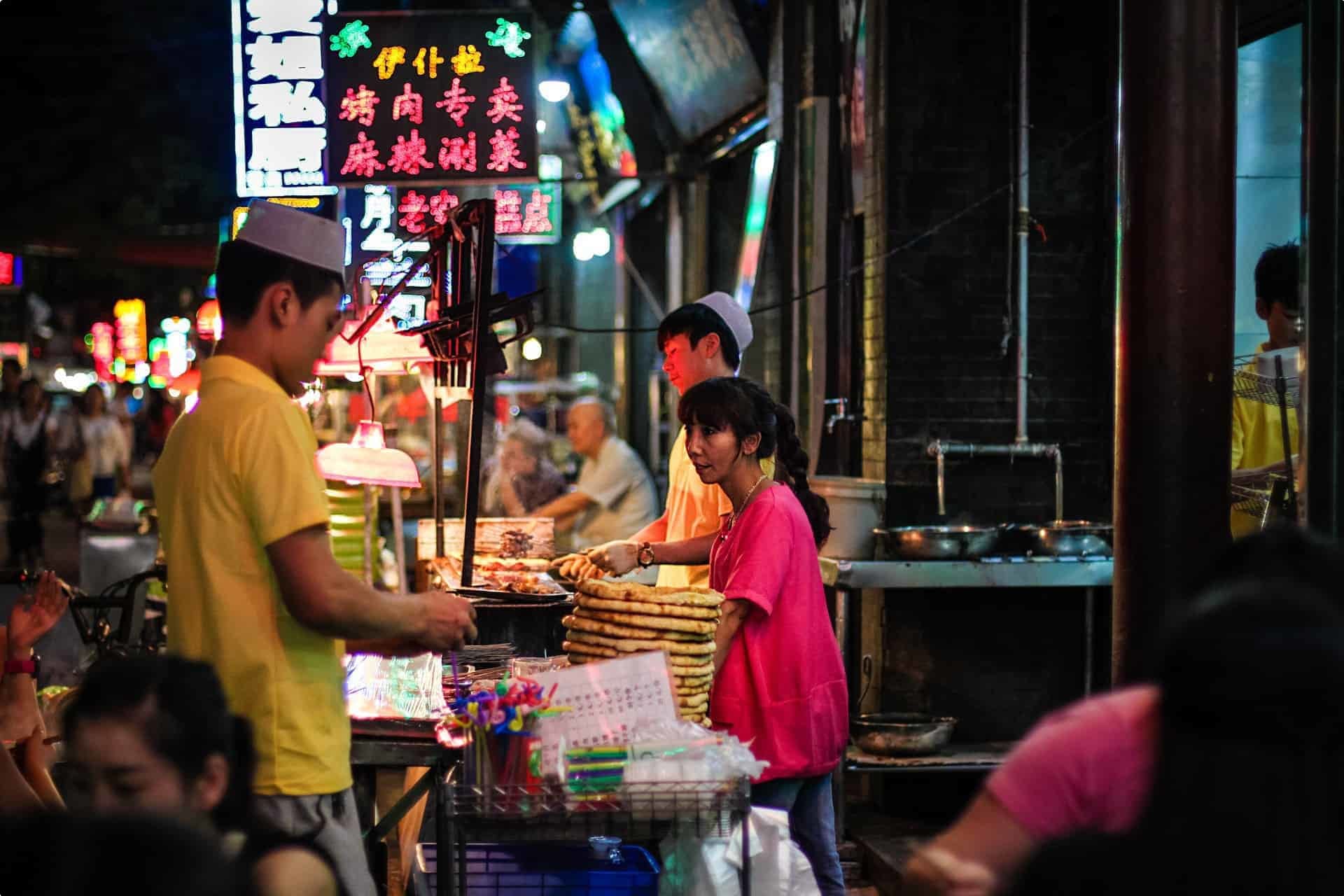
Typical night-life in Beijing
If you wish to obtain a visa for China from within Mongolia, allow four to five days. Documentation including details of your onward stay must be produced, but a local travel agency can assist you with this. Long queues form during August and September as students wait for their visas, so be prepared to be turned away if you do not arrive in time. And for Chinese visas issued from Russia, an invitation letter, hotel booking, itinerary and onward flight must be provided.
Visas for Russia
A valid Russian visa is required by all visitors to Russia and you should apply for one before you leave home. A 30-day tourist visa is sufficient for most travellers, and an invitation can be issued by a travel agent, Russian hotel or specialised visa agency.
On arrival in Russia, your visa must be registered within seven working days. The obligation to register lies with your host, such as your hotel – a service for which you will be charged a small fee. On registration, you will receive a slip of paper confirming the dates of the accommodation, and this must be retained because police may request this information. You must repeat this process every time you stay more than seven days in a particular location. It’s best to keep all of your transport tickets too. Some travellers will take a relaxed attitude toward registration, but it is worth being covered, especially if you are travelling to destinations that lie off the beaten track.
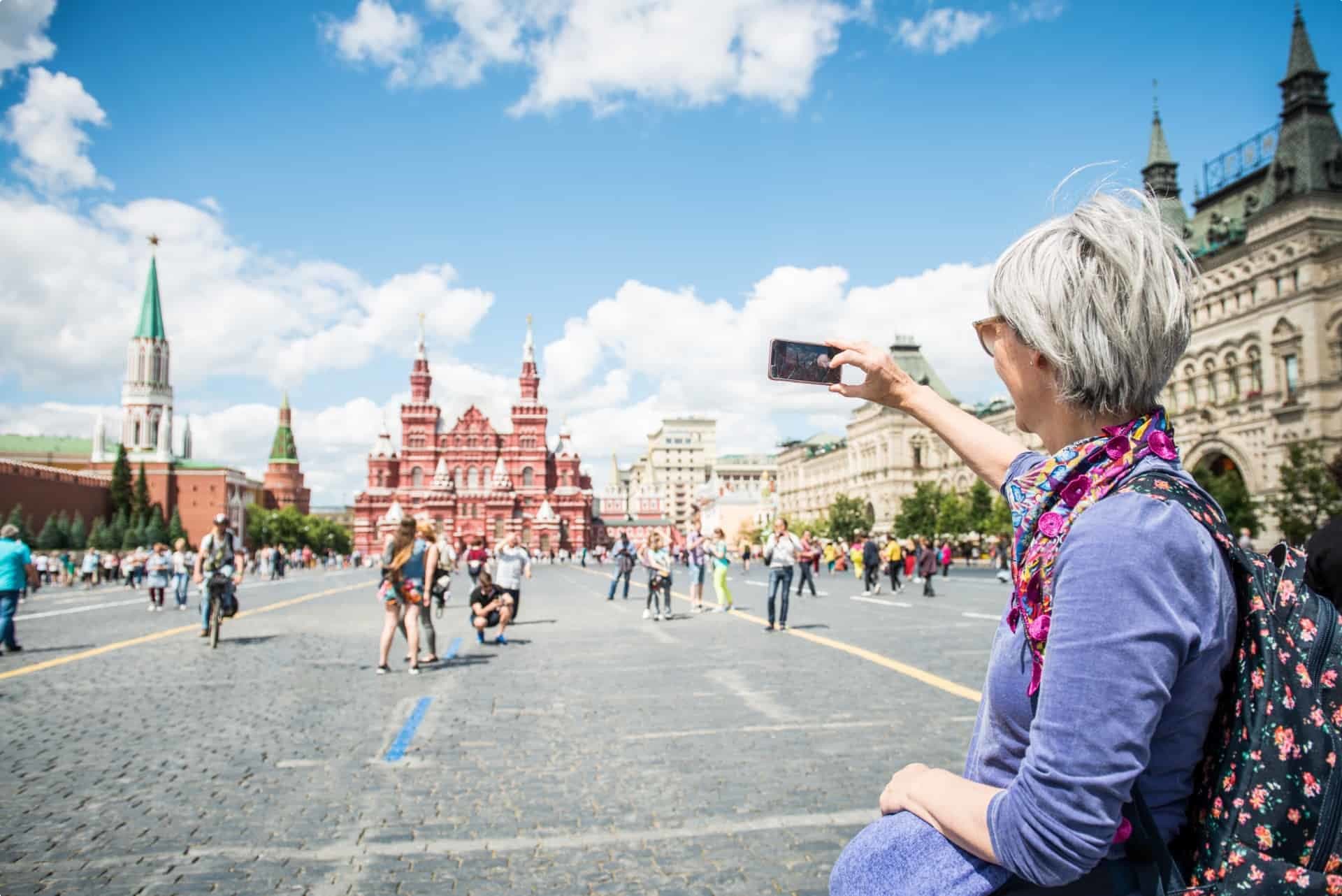
A trans-Siberian overview
Remember, this information is designed to give you an overview of ticketing and visas for the trans Siberian railway. It indicates the need to plan in advance and, if possible, seek out the services of a travel agency whether at home or abroad. An organised tour is a good way to circumvent some of the potential for travel mishaps. But when taking this historic route, bring your patience, openness and wits to ensure a pleasurable experience.
Capturing a picture of Moscow‘s Red Square
Tips for your trans Siberian rail adventure
- Greet fellow passengers when you first enter the compartment. Also consider offering food to your fellow compartment mates. Not only does this honour cultural etiquette, it will also be a great icebreaker
- Wear loose fitting and comfortable clothing on your overnights. Tracksuit pants may not be the height of fashion but they can double as pyjamas, and that is very useful
- Pack a warm coat, hat, gloves and lip cream for use during chilly station stops
- Be aware of signals by other members in your compartment to give them privacy to dress
- Pack a small torch (flashlight) which may be helpful during the night
- Bring along some earplugs and an eye mask – an asset not just for your flights over but in case you are disturbed by white noise or light
- It is rare for a train to have showers aboard, even in first class. For this reason, we recommend packing a flannel or facecloth for washing during overnight trips
- Slip-on shoes (flip flops, jandals or thongs) are very handy for visits to the bathroom, to save you standing on the cold floor
- Pack a basic kit of eating utensils, including cutlery, a mug and plate. This makes it easier to access the hot water in the samovar, and also to enjoy the picnic-style eating the locals often practice, using supplies from the platforms. A reusable water bottle will be helpful too, but take care to fill it with drinkable water
- Although toilet paper is supplied, it is worth packing your own – just in case!
- Store your valuables in a money belt or ankle stash, or at least within a zipped pocket. Overnight, the safest option is just to tuck them into your pillowcase
- Lock your compartment overnight, and if you need to leave it (and your belongings) unattended for a long station stop or restaurant car visit, ask the provodnitsa to lock it from the outside
Odyssey has several trans Siberian railway tours currently in development. They will round out a series of rail journeysthat we offer across the world, including journeys through France and Japan . If you have a special interest in the Siberian region, we also offer several tours in Mongolia, China and Russia.
Odyssey has several trans-Siberian railway tours currently in development. They will round out a series of rail journeys that we offer across the world, including journeys through France and Japan. If you have a special interest in the Siberian region, we also offer several tours in Mongolia, China and Russia.

About Odyssey Traveller
Odyssey Traveller is famous for our small groups, and we average eight participants per tour. Our maximum group size is eighteen people, which ensures quality, flexibility and care that is tailored to our clients. We specialise in small group tours for the senior traveller who is seeking adventure or is curious about the world we live in. Typically, our clients begin travelling with us from their mid 50’s onward. But be prepared to meet fellow travellers in their 80s and beyond! Both couples and solo travellers are very welcome on our tours.

Odyssey Traveller is committed to charitable activities that support the environment and cultural development of Australian and New Zealand communities. Accordingly, we are pleased to announce that since 2012, Odyssey has been awarding $10,000 Equity & Merit Cash Scholarships each year. We award scholarships on the basis of academic performance and demonstrated financial need. We award at least one scholarship per year. We’re supported through our educational travel programs, and your participation helps Odyssey achieve its goals.
For more information on Odyssey Traveller and our educational small group tours, visit our website. Alternatively, please call or send an email. We’d love to hear from you
Related Tours
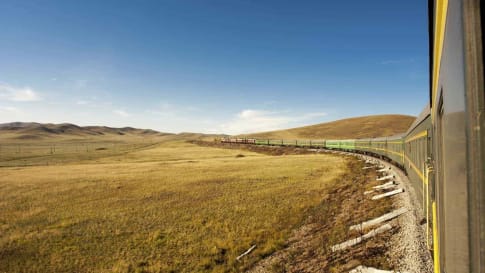
days
JulJourney through Mongolia and Russia small group tour
Visiting Mongolia, Russia
This escorted small group tour traverses this expanse, from Ulaanbaatar to St Petersburg; from the Mongolian Steppes to Siberian taiga and tundra; over the Ural Mountains that divide Asia and Europe to the waterways of Golden Ring. Our program for couples and solo travellers uses two of the great rail journeys of the world; the Trans Mongolian Express and the Trans Siberian Express.
From A$17,850 AUD
View Tour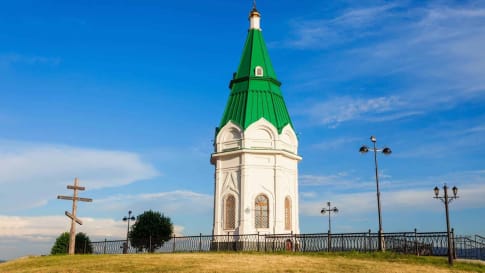
days
Oct, MayHelsinki to Irkutsk on the Trans-Siberian Railway
Visiting Finland, Russia
Escorted tour on the Trans-Siberian railway network from West to East starting in Helsinki and finishing in Irkutsk after 21 days. This is small group travel with like minded people and itineraries that maximise the travel experience of the 6 key destinations explored en-route. Our small group journeys are for mature couples and solo travellers.

days
Apr, AugIrkutsk to Helsinki on the Trans-Siberian Railway
Visiting Finland, Russia
Escorted tour on the Trans-Siberian railway network from East to West starting in Irkutsk and finishing in Helsinki after 21 days. This is small group travel with like minded people and itineraries that maximise the travel experience of the 6 key destinations explored en-route. Our small group journeys are for mature couples and solo travellers.
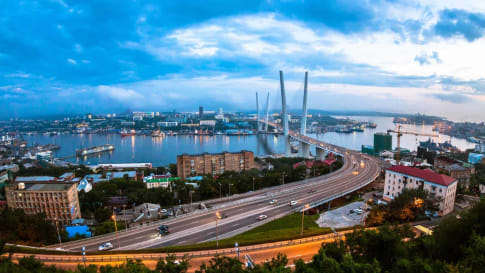
22 days
Apr, AugVladivostok to Krasnoyarsk on the Trans-Siberian Railway
Visiting Russia
Mature and solo travelers group Travel on the Trans-Siberian Railway for 22 days covering the second half of the Trans-Siberian journey, from Vladivostok to Krasnoyarsk in the heart of Siberian Russia Small group journeys with a tour leader, explores 5 key cities with local guides providing authentic experiences in each with stops of 2-3 nights.
From A$12,560 AUD
View Tour